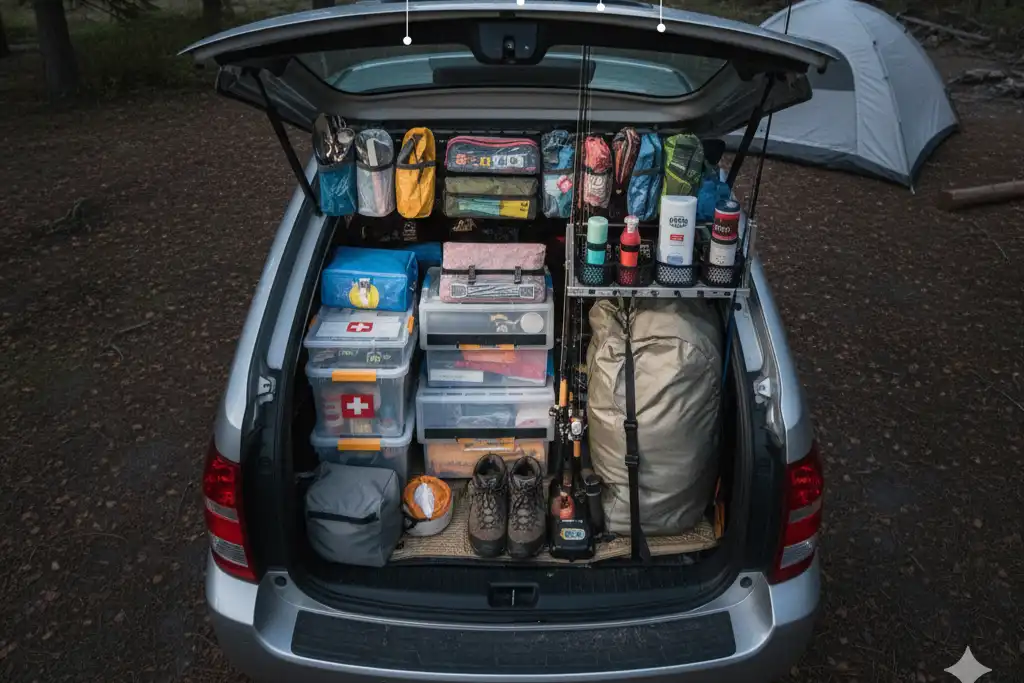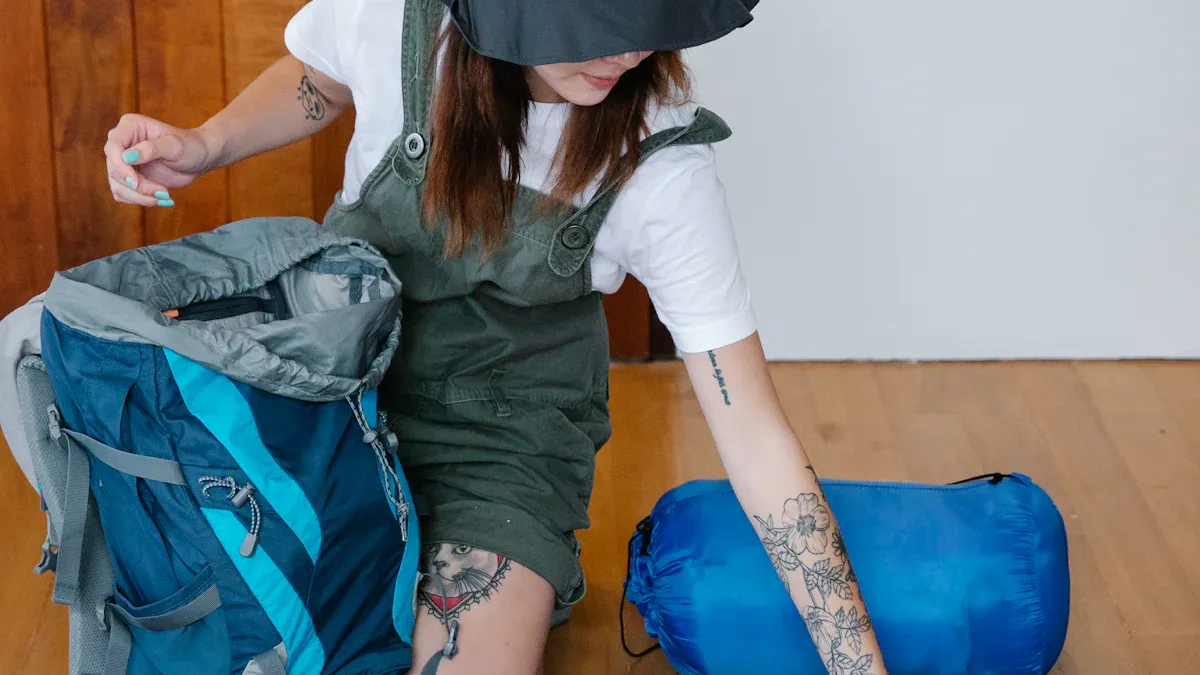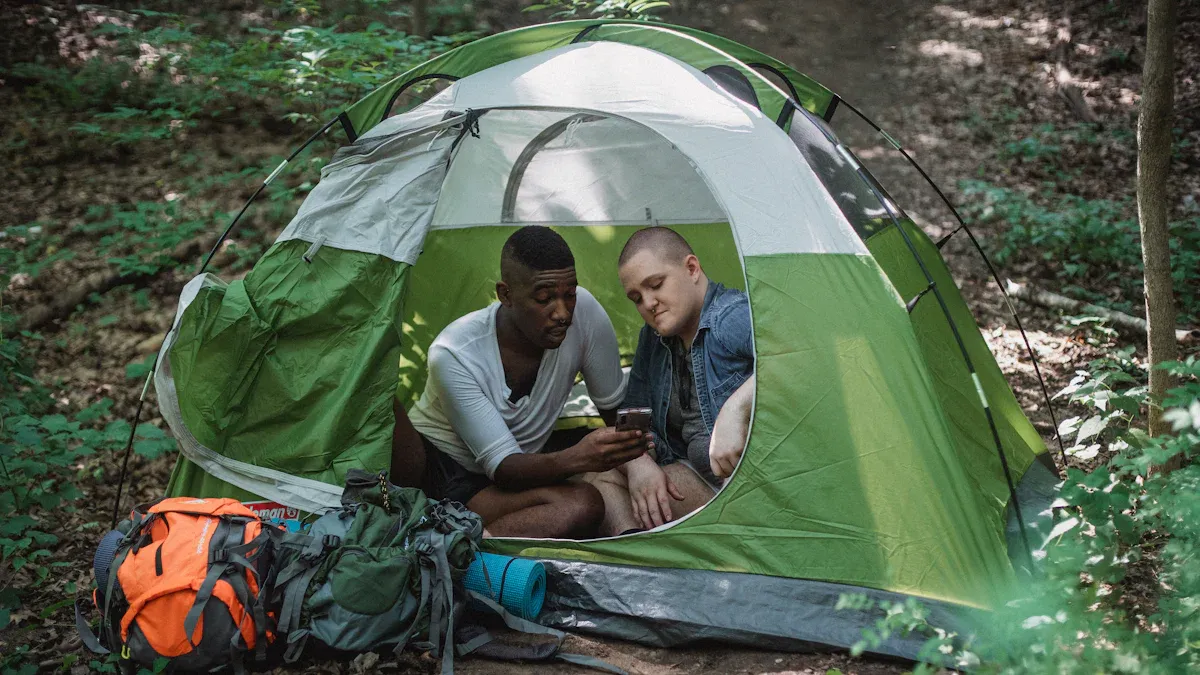How to Stay Organized During Camping: Bag Tips and Hacks

Staying organized during camping means smart packing, using the right bags and bins, and keeping your campsite tidy.
Last summer, you might remember scrambling to find your flashlight in the dark or digging through a messy backpack for snacks. Organization changes everything.
- You’ll discover real tips for keeping your gear sorted, your food easy to grab, and your campsite clean. Simple tricks can make your next trip smoother and way more fun.
Key Takeaways
- Make a gear checklist before you go camping. This helps you remember important things. Try using apps like PackPoint to keep track of your list.
- Put similar things together in bags. This makes packing and unpacking easier. It also saves time and helps you feel less stressed when camping.
- Pick the best bags for your gear. Use duffels for big items. Use backpacks when you go hiking. This keeps your stuff neat and easy to find.
- Set up your campsite with special areas for each type of gear. This helps you find things fast. It also keeps your campsite clean.
- Make daily habits for packing up and cleaning. These routines help you stay organized. They also make camping more fun.
Pre-Trip Camping Prep
Gear Checklist
Before you head out, start with a solid checklist. This step helps you avoid those “Oops, I forgot it!” moments at the campsite. Many campers leave behind important things without realizing it. Here are some of the most commonly forgotten items:
- Toilet paper
- First aid kits
- Dishwashing supplies
- Extra socks
- Tablecloths
- Tent stakes or poles
- Bug spray
- Sunscreen
You can use apps like PackPoint or Notion to create and manage your list. These tools let you check off items as you pack, so nothing gets left behind. Recreation.gov is also handy for finding campsites and making reservations. MyRadar helps you keep an eye on the weather, so you can pack smart.
Tip: Double-check your list the night before you leave. It’s easy to miss something when you’re excited about your trip!
Bundle Similar Items
Grouping similar items together makes packing and unpacking much easier. For example, keep all your cooking gear in one bag and your hygiene items in another. Bundling items this way saves time and helps you find things fast. It also keeps your mind clear, so you don’t feel overwhelmed by choices. When you know where everything is, you can focus on having fun instead of searching for gear.
Packing Strategy
A good packing strategy keeps your trip stress-free. Try these tips from experienced campers:
- Make a list of essentials and stick to it.
- Use vertical space in your car or tent with hanging organizers.
- Bring multipurpose items, like a folding table that works for meals and games.
- Only pack what you need for your trip’s length and location.
Staying organized also helps in emergencies. When you know where your first aid kit and other supplies are, you can act quickly if something goes wrong. Clear roles and teamwork make everyone safer and more prepared.
Camping Bag Packing Tips

Choose the Right Bags
Picking the right bag can make your camping trip much easier. You want bags that fit your gear, keep things dry, and help you stay organized. Outdoor experts recommend several types of bags for different needs:
- 85L duffle: Great for blankets, sleeping bags, clothes, and shoes. You can fold it flat when you don’t need it.
- Mountain Classic Cordura Duffel: Tough nylon, easy-to-open zipper, and a padded strap for comfort.
- Co-op Trail 40 Pack: Backpack style, made from recycled materials, with lots of pockets and a spot for a water reservoir.
- Base Camp Voyager Duffel: Lightweight and made from recycled material. It has many pockets for sorting your stuff.
- Carry-It-All Bag: Perfect for fishing trips, with padded dividers and a secure zipper.
- Heritage Sportsman Bag: Durable and easy to open, with water-resistant pockets.
- Heavy-Haul Duffel: Made for heavy loads, with a collapsible pocket inside.
Think about what you need to carry. If you have a lot of clothes or bulky items, a big duffle works well. For hiking, a backpack with compartments keeps things handy. Always choose bags that match your trip.
Use Bins and IKEA Bags
You can use bins and IKEA bags to keep your gear sorted and easy to find. Many campers love these because they make packing and unpacking simple.
- Camping bins help you organize your gear. You can see what’s inside and grab what you need fast.
- Having a bin ready with essentials saves time when you pack for your next trip.
- When everything has a place, you feel less stressed and don’t waste time searching for things.
IKEA bags are strong, lightweight, and hold a lot. You can use them for dirty laundry, food, or even as a tote for firewood. Stackable bins fit in your car and keep your campsite tidy. Try using one bin for kitchen items, one for tools, and another for clothes.
Tip: Use lightweight, water-resistant containers like empty coffee cans or plastic jars for small items. These keep things dry and easy to spot.
Packing Cubes and Pouches
Packing cubes and pouches help you keep your things neat and easy to reach. You can separate clean and dirty clothes, or group items by type. This way, you don’t have to dig through your whole bag to find a pair of socks or your toothbrush.
Packing cubes let you organize by color or size. You might use one for shirts, another for pants, and a small pouch for chargers or headlamps. This system saves time and keeps your tent or car from turning into a mess. You can also use mesh pouches for wet items, so they dry out faster.
Label and Color-Code
Labels and color-coding make it simple to find what you need, even in the dark or when you’re in a hurry. Here’s how you can set up your own system:
- Label containers with their contents, like “First Aid,” “Snacks,” or “Cooking Gear.”
- Use color codes to tell items apart. For example, blue for camping gear, red for food, green for hygiene.
- Organize gear by color so you can spot things quickly, which helps when you plan trips ahead of time.
- Color organizing is great for emergencies. You can grab what you need without thinking twice.
- Use clear labels and colored tape on bins for fast identification.
- Try a system that mixes color coding with written labels for the best results.
Note: A color-coded system works well if you like to keep things neat and want to save time at camp.
With these bag tips and hacks, you can keep your camping gear organized and your trip stress-free. You’ll spend less time searching and more time enjoying the outdoors.
Campsite Setup

Getting your campsite organized right from the start makes your whole trip smoother. You can find what you need fast, keep your space safe, and enjoy more time relaxing. Here’s how you can set up your site for maximum comfort and efficiency.
Unpack for Access
When you arrive, start unpacking right away. This helps you avoid the temptation to leave things in a pile, which can lead to chaos later. Place your bags and bins in spots where you can reach them easily. Keep similar items together, like all your cooking gear in one spot and your sleeping gear in another. This way, you always know where to look.
- Clean your gear before you pack it for the trip. This saves you work at the campsite.
- Unpack in the reverse order you packed. The last things you packed should be the first things you need.
- Store related items together. For example, keep your lantern, headlamp, and extra batteries in one pouch.
- Put things back in the same place after each use. This habit helps you stay organized and makes packing up at the end of your trip much easier.
Tip: If you notice any broken gear or missing supplies, make a note right away. You can fix or replace them before your next adventure.
A smart setup keeps your essentials handy and reduces the risk of losing things. You spend less time searching and more time enjoying the outdoors.
Food Storage Zone
Food attracts animals, so you need a safe and tidy food zone. Set up your food area away from your sleeping spot—at least 15 feet if you can. Use sturdy containers to keep food fresh and critters out.
| Method | Description |
|---|---|
| Airtight containers or coolers | Keep food fresh and block smells from escaping. |
| Bear-proof containers | Use these in bear country to protect both you and wildlife. |
| Bear bags or canisters | Hang these from a tree branch to keep food out of reach of animals. |
| Designated food storage boxes | Use campsite boxes or your car if allowed, to keep food safe and secure. |
- Keep all your snacks, meal ingredients, and cooking tools together. This makes meal prep quick and easy.
- Use airtight containers to seal in smells and keep food dry.
- Store food in a cooler or a locked bin when you’re not eating.
- Never leave food out overnight or unattended.
Note: Keeping your food zone organized helps protect wildlife and keeps your campsite clean.
Bag Zones
Divide your campsite into zones for different types of gear. This trick comes straight from home organization. You can use color-coded bags, see-through bins, or labeled containers to sort your stuff.
- Color code your dry bags. For example, use blue for clothes, red for first aid, and green for kitchen gear.
- Use see-through bins so you can spot what’s inside without opening every box.
- Assign pockets in your backpack for toiletries, snacks, and extra layers.
- Place quick-access items like your first aid kit or flashlight in outer pockets or at the top of your bag.
- Stack bins or bags in a way that keeps walkways clear and your tent clutter-free.
Try this: Set up a “backup gear” zone with extra supplies in a waterproof bin. You won’t need to dig through everything if you need a spare item.
You can also create zones for sleeping, cooking, socializing, and storage. Use vertical organizers or hanging shelves to save space, just like you would at home. Label each bin or bag clearly so everyone knows where things go.
A well-organized campsite keeps your trip stress-free. You avoid overpacking, reduce the risk of forgetting important items, and help protect the environment by keeping your area tidy. When you use these simple tricks, you turn your campsite into a cozy, efficient home away from home.
Daily Organization
Keeping your campsite organized each day makes your trip smoother and more enjoyable. You can follow a few simple routines to keep everything tidy and ready for action.
Repack Each Day
Start your morning by repacking your gear. This habit helps you find things quickly and keeps your campsite neat. Here’s how expert campers stay on top of their gear:
- Establish routines. Doing the same tasks each day helps everyone know what to expect.
- Simplify directions. Give yourself or your group one task at a time, like packing away sleeping bags or sorting food.
- Use smart storage. Keep your items in the same spot so you always know where to look.
- Daily repacking makes it easier to grab what you need.
- You stay efficient because everything is in its place.
- Checking your gear each day helps you stay prepared for surprises.
Carry an extra dry bag for wet clothes or sweaty items. Use mesh packing cubes to separate clean and dirty clothes. Never pack clean clothes with dirty ones—this small step keeps everything fresh.
Quick Cleanups
Quick cleanups keep your campsite safe and comfortable. Try these strategies:
| Strategy | Description |
|---|---|
| Group Effort | Get everyone involved to finish cleaning faster. |
| Washing Gear | Use a bucket or lightweight container for washing dishes and utensils. |
| Pre-cooked Food | Prepare meals at home to cut down on cooking and cleaning at camp. |
Tip: Make cleanup a game or race. You’ll finish faster and have more time for fun.
Hygiene and Cleanliness
Good hygiene keeps you healthy during your camping adventure. Follow these tips:
- Wash your hands before eating, after using the bathroom, and after handling food.
- Bring toilet paper, hand sanitizer, and a sealable bag for used paper.
- Dig a hole at least 200 feet from camp for bathroom needs.
- Leave shoes outside your tent to keep dirt and germs out.
- Change socks often and wash your feet to avoid infections.
- Switch underwear daily for comfort.
- Keep a travel toothbrush and toothpaste handy.
- Rinse off before swimming in lakes or rivers. Clean up at least 200 feet from water sources.
Learn about Leave No Trace ethics. One of the best things you can do for your fellow campers is to leave the ground as clean or cleaner than you found it.
By following these daily habits, you keep your camping trip organized, safe, and comfortable.
You can make camping easier with a few smart organization hacks. Try using checklists, family zones, and collapsible bins to keep your space tidy. Many campers love simple tricks like hanging a shoe organizer or storing toilet paper in a coffee can. These ideas do not cost much but make a big difference. Give these tips a try on your next trip. Got your own favorite hack? Share it in the comments and help others enjoy a clutter-free adventure!
FAQ
How do I keep my tent organized during a camping trip?
You can use small bins or hanging organizers for your gear. Put shoes outside the tent. Keep sleeping bags and clothes in separate bags. Always return items to their spot after using them.
What’s the best way to store food at camp?
Store food in airtight containers or coolers. Use a bear-proof box if you camp in bear country. Keep all food away from your sleeping area. Group snacks and meal items together for easy access.
How do I handle dirty or wet clothes while camping?
Pack a separate dry bag or mesh pouch for dirty or wet clothes. Change out of wet clothes as soon as possible. Hang wet items on a line to dry. Never mix clean and dirty clothes.
Can I use regular bags instead of camping-specific bags?
Yes, you can use sturdy tote bags, IKEA bags, or plastic bins. Just make sure they keep your gear dry and organized. Label each bag so you know what’s inside.
What should I do if I lose something at camp?
Stay calm. Check each zone or bag where you keep similar items. Ask your group if they’ve seen it. Make a note so you remember to pack a replacement next time.
See also
How to Cooperate with Chinese Outdoor Bag Manufacturers
Best Waterproof Lining Fabric for Bags



Comments are closed